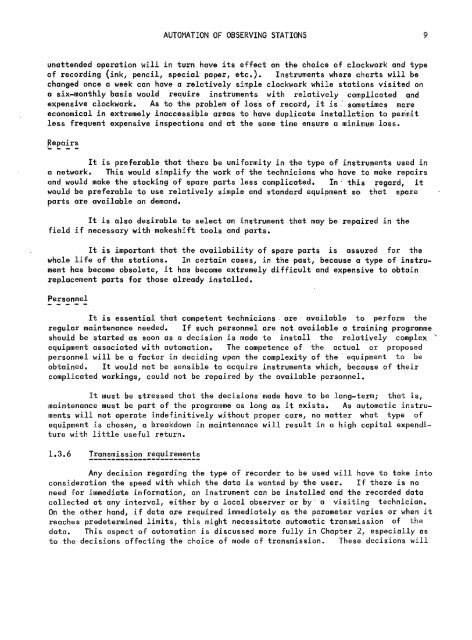automatic collection and transmission of ... - E-Library - WMO
automatic collection and transmission of ... - E-Library - WMO
automatic collection and transmission of ... - E-Library - WMO
You also want an ePaper? Increase the reach of your titles
YUMPU automatically turns print PDFs into web optimized ePapers that Google loves.
AUTOMATION OF OBSERVING STATIONS 9unattended aperation will in turn have its effect on the choice <strong>of</strong> clockwork <strong>and</strong> type<strong>of</strong> recording (ink, pencil, special paper, etc.). Instruments where charts will bechanged once a week can have a relatively simple clockwork while stations visited ona six-monthly basis would require instruments with relatively complicated <strong>and</strong>expensive clockwork. As to the problem <strong>of</strong> loss <strong>of</strong> record, it is.· sometimes moreeconomical in extremely inaccessible areas to have duplicate installation to permitless frequent expensive inspections <strong>and</strong> at the same time ensure a minimum loss.It is preferable that there be uniformity in the type <strong>of</strong> instruments used ina network. This would simplify the work <strong>of</strong> the technicians who have to make repairs<strong>and</strong> would make the stocking <strong>of</strong> spare parts less complicated. In· this _egard, itwould be preferable to use relatively simple <strong>and</strong> st<strong>and</strong>ard equipment so that spareparts are available on dem<strong>and</strong>.It is also desirable to select an instrument that may be repaired in thefield if necessary with makeshift tools <strong>and</strong> parts.It is important that the availability <strong>of</strong> spare parts is assured for thewhole life <strong>of</strong> the stations. In certain cases, in the past, because a type <strong>of</strong> instrumenthas become obsolete, it has become extremely difficult <strong>and</strong> expensive to obtainreplacement parts for those already installed.PersonnelIt is essential that competent technicians are available to perform theregular maintenance needed. If such personnel are not available a training programmeshould be started as soon as a decision is made to install the relatively complex 'equipment associated with automation. The competence <strong>of</strong> the actual or proposedpersonnel will be a factor in deciding upon the complexity <strong>of</strong> the equipment to beobtained. It would not be sensible to acquire instruments which, because <strong>of</strong> theircomplicated workings, could not be repaired by the available personnel.It must be stressed that the decisions made have to be long-term; that is,maintenance must be part <strong>of</strong> the programme as long as it exists. As <strong>automatic</strong> instrumentswill not operate indefinitively without proper care, no matter what. type <strong>of</strong>equipment is chosen, a breakdown in maintenance will result in a high capital expenditurewith little useful return.1.3.6Any decision regarding the type <strong>of</strong> recorder to be used will have to take intoconsideration the speed with which the data is wanted by the user. If there is noneed for immediate information, an instrument can be installed <strong>and</strong> the recorded datacollected at any interval, either by a local observer ar by· a visiting technician.On the other h<strong>and</strong>, if data are required immediately as the parameter varies or when itreaches predetermined limits, this might necessitate <strong>automatic</strong> <strong>transmission</strong> <strong>of</strong> thedata. This aspect af autamation is discussed more fully in Chapter 2, especially asta the decisions affecting the choice <strong>of</strong> mode <strong>of</strong> <strong>transmission</strong>. These decisions will
















